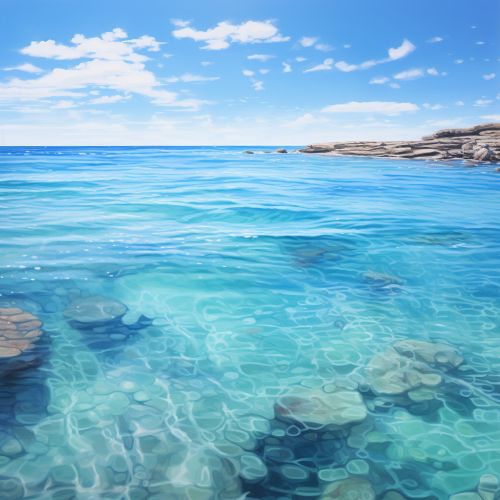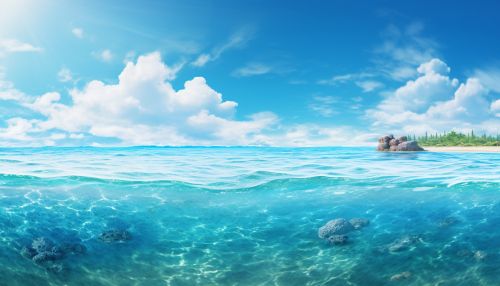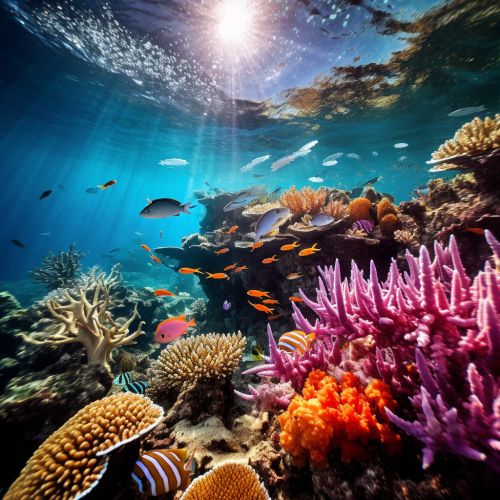Earth's Oceans
Introduction
The Earth's oceans are a vast and complex system of interconnected bodies of salt water that cover approximately 71% of the planet's surface. They are divided into five primary oceans: the Atlantic Ocean, the Indian Ocean, the Southern Ocean, the Arctic Ocean, and the largest, the Pacific Ocean. These oceans play a crucial role in the Earth's climate system, providing a significant heat reservoir that helps to regulate the planet's temperature and weather patterns.


Formation and Characteristics
The Earth's oceans were formed over billions of years, primarily through the process of outgassing from the Earth's interior and the condensation of water vapor in the Earth's early atmosphere. They are primarily composed of water, with an average salinity of about 3.5%. This means that for every 1,000 kilograms of seawater, there are 35 kilograms of dissolved salts, mostly sodium chloride, commonly known as table salt.
Oceanic Zones
The oceans can be divided into different zones, each with its own unique characteristics and ecosystems. The epipelagic zone, also known as the sunlight zone, extends from the surface to a depth of about 200 meters. This is where the majority of the ocean's photosynthesis occurs, thanks to the abundance of sunlight.
Below the epipelagic zone is the mesopelagic zone, or twilight zone, which extends from 200 to 1,000 meters below the surface. Here, the sunlight starts to disappear, and the water pressure significantly increases.
The bathypelagic zone, or midnight zone, ranges from 1,000 to 4,000 meters. The pressure here is extreme, and the temperatures are near freezing. Despite these harsh conditions, a variety of life forms have adapted to survive here.
The abyssopelagic zone, or abyss, extends from 4,000 to 6,000 meters. The pressure here is immense, and the temperatures are just above freezing. Life in the abyss is sparse, with organisms adapted to the extreme conditions.
Finally, the hadalpelagic zone, or the trenches, is the deepest part of the ocean, extending from 6,000 meters to the bottom of the deepest parts of the ocean. The most famous of these is the Mariana Trench in the western Pacific Ocean, which reaches a depth of about 11,000 meters.
Oceanic Life
Life in the ocean varies greatly, from tiny phytoplankton that form the base of the ocean food web to the largest animal on Earth, the blue whale. The oceans are home to a vast array of ecosystems, including coral reefs, kelp forests, and deep-sea vent communities.


Oceanic Currents
The movement of water in the Earth's oceans, known as ocean currents, is driven by a complex system of forces, including the rotation of the Earth, wind, temperature, and salinity differences. These currents play a crucial role in regulating the Earth's climate, distributing heat from the equator towards the poles.
Human Interaction and Impact
Humans have interacted with the oceans for thousands of years, using them for transportation, food, and recreation. However, human activities have also had a significant impact on the oceans. Overfishing has led to the decline of many fish species, while pollution, particularly plastic waste, has had a devastating effect on marine life. Climate change, driven by human-induced increases in greenhouse gas emissions, is causing ocean warming and acidification, which pose significant threats to marine ecosystems.
Conservation Efforts
In response to these threats, various conservation efforts are underway to protect the Earth's oceans and their biodiversity. These include the establishment of marine protected areas, restrictions on fishing, and efforts to reduce pollution. International agreements, such as the Paris Agreement, aim to mitigate the effects of climate change, including those affecting the oceans.
